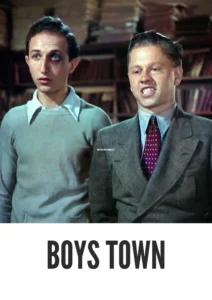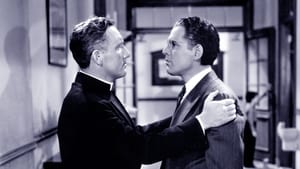Video Sources 0 Views

Download Boys Town (1938) Colorized HD | Spencer Tracy | Sentimental Classic
Synopsis
Redemption, Hope, and a Boy’s Town: Boys Town (1938) in Stunning Color

Step into the inspirational world of Boys Town, a sentimental classic from 1938, now beautifully colorized for a viewing experience like never before. This film, directed by Norman Taurog, delivers a heartwarming blend of drama and hope within the walls of a unique haven for young boys. Perfect for classic film enthusiasts and those seeking a touching story of redemption, this HD download brings a timeless piece of cinematic history to your screen. Men of Boys Town is a sequel to the movie.
Boys Town Storyline: A Sanctuary of Second Chances
Boys Town tells the story of Father Flanagan (Spencer Tracy), a Catholic priest who dedicates his life to helping troubled and homeless boys. He establishes Boys Town, a self-governing community where these boys can find a home, an education, and a chance to turn their lives around.One of the boys, Whitey Marsh (Mickey Rooney), is a hardened delinquent who initially resists Father Flanagan’s guidance. Through Flanagan’s unwavering patience and understanding, Whitey eventually learns the value of trust, responsibility, and community. Boys Town explores themes of redemption, the power of faith, and the importance of providing opportunities for disadvantaged youth. The film culminates in a powerful message of hope and the belief in the potential for good in every individual. Ultimately, Boys Town is a moving and inspirational story that celebrates the triumph of the human spirit.
Movie Cast
The film features a talented cast of actors who bring this inspirational story to life:
- Spencer Tracy as Father Flanagan
- Mickey Rooney as Whitey Marsh
- Henry Hull as Dave Morris
- Leslie Fenton as Joe Benton
- Gene Reynolds as Tony Ponessa
Movie Genre
Boys Town falls into the genre of sentimental drama, with elements of hope and inspiration.
Historical Context: Golden Age of Hollywood and Social Reform
Released in 1938, Boys Town arrived during the Golden Age of Hollywood, a period known for its socially conscious films. The film reflects the era’s interest in social reform and the belief in the power of community to address societal problems. Boys Town was a critical and commercial success, winning multiple Academy Awards, including Best Actor for Spencer Tracy and Best Writing, Original Story. The film’s positive message and heartwarming story resonated with audiences, solidifying its place as a beloved classic.
Colorization Details
This colorized version of Boys Town has been meticulously restored using modern digital techniques, enhancing the visual appeal while preserving the film’s original emotional depth. The colorization process involved carefully analyzing the grayscale tones of the original black and white footage and assigning appropriate colors to each scene. While the specific software used remains proprietary, the techniques employed included advanced algorithms for color palette selection and image enhancement. This painstaking process brings new life to the characters and settings, making the story even more engaging for modern audiences. While some may debate the merits of colorizing classic films, it introduces these films to a broader audience, ensuring their legacy for future generations.
Technical Details
- Director: Norman Taurog
- Screenplay: John Meehan, Dore Schary
- Story: Eleanore Griffin, Dore Schary
- Cinematography: Sidney Wagner
- Edited by: Elmo Veron
- Production Company: Metro-Goldwyn-Mayer
- Distributed by: Metro-Goldwyn-Mayer
- Runtime: 96 minutes
Technical Specifications
- Download Format: MP4
- Resolution: HD (1080p)
- Compatibility: Compatible with most devices, including smartphones, tablets, computers, and smart TVs.
Reviews and Critical Reception
Boys Town (1938) is celebrated for its heartwarming story, powerful performances, and positive message. Spencer Tracy’s portrayal of Father Flanagan is widely regarded as one of his finest performances, earning him an Academy Award. The film’s depiction of Boys Town as a sanctuary for troubled youth has resonated with audiences for generations, making it a beloved and enduring classic. As an inspiring and uplifting film, Boys Town continues to offer a message of hope and the belief in the potential for good in every individual.
FAQs
- Q: What is Boys Town about?
- A: Boys Town tells the story of Father Flanagan and his work with troubled and homeless boys, creating a self-governing community where they can find a home and a future.
- Q: Is Boys Town (1938) considered a classic film?
- A: Yes, Boys Town is a widely recognized and beloved classic, known for its heartwarming story and powerful performances.
- Q: Is this version of Boys Town colorized?
- A: Yes, this version has been professionally colorized to enhance the viewing experience.
- Q: What makes Boys Town an inspiring film?
- A: Boys Town offers a message of hope, redemption, and the belief in the potential for good in every individual, making it an enduring and uplifting story.
- Q: What is the download format?
- A: The download format is MP4, which is compatible with most devices.
- Q: What resolution is the download?
- A: The resolution is HD (1080p), providing a high-quality viewing experience.
Download Now in HD!
Watch Boys Town Today!












